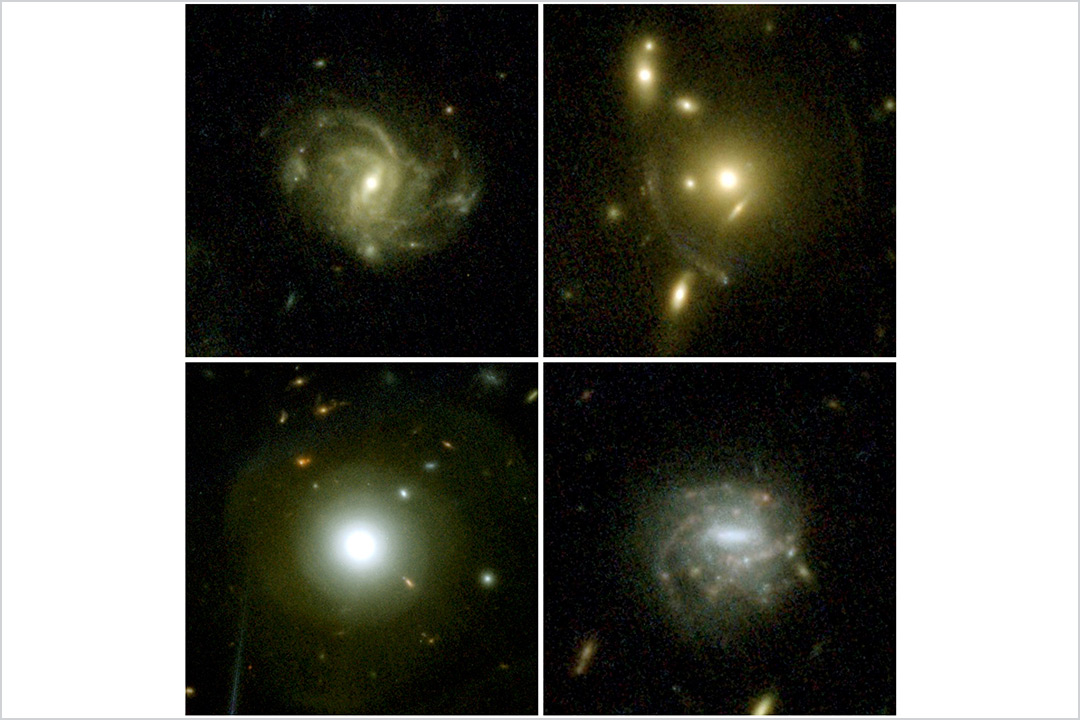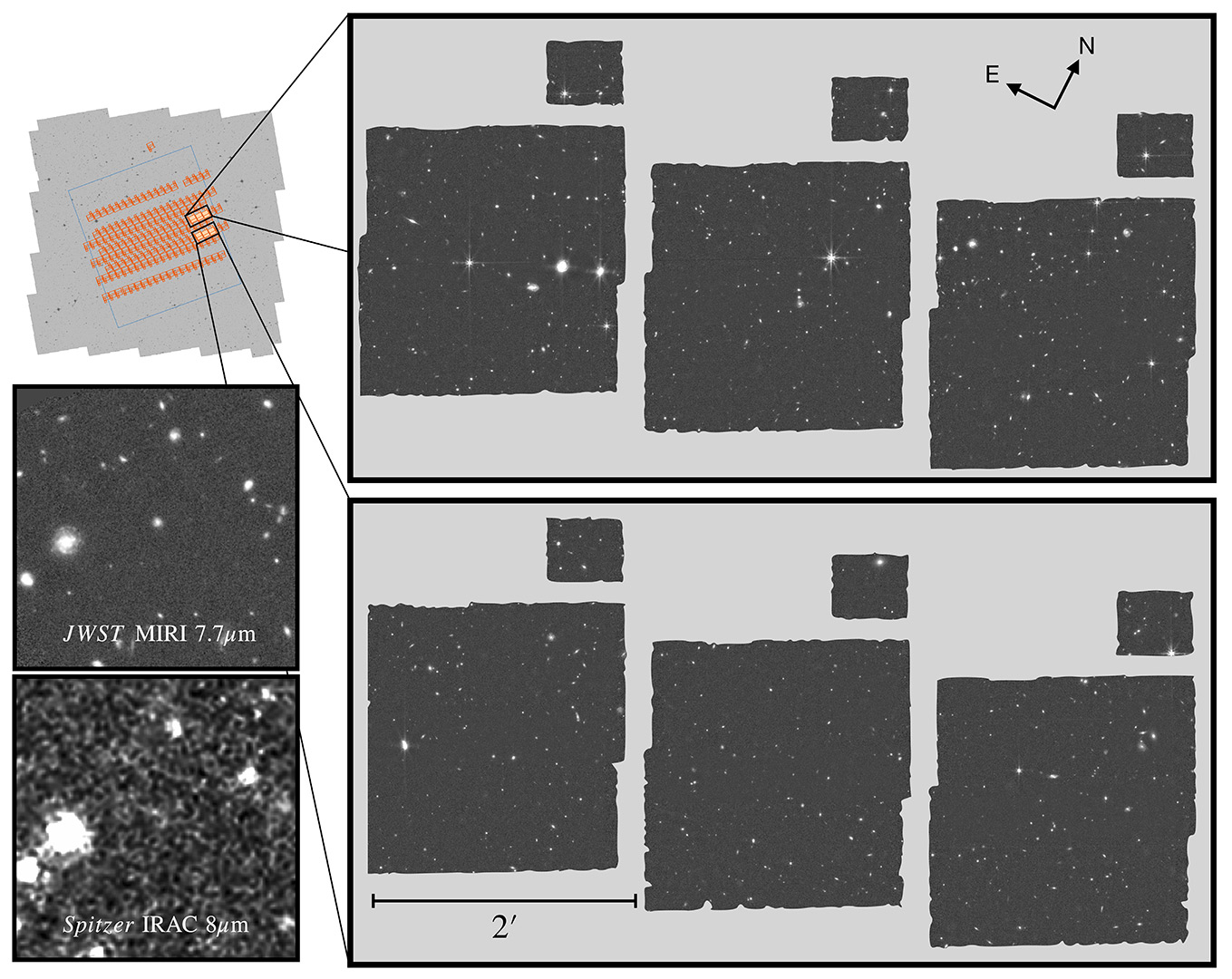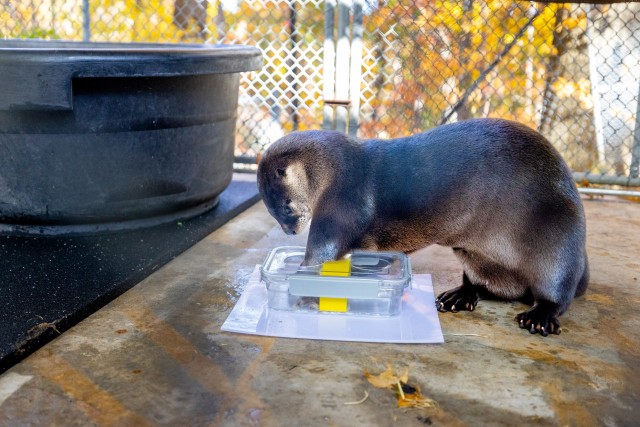First images released from James Webb Space Telescope’s largest general observer program
Mosaic images from the COSMOS-Web program offer a treasure trove of early galaxies
Images of four example galaxies selected from the first epoch of COSMOS-Web NIRCam observations, highlighting the range of structures that can be seen. In the upper left is a barred spiral galaxy; in the upper right is an example of a gravitational lens, where the mass of the central galaxy is causing the light from a distant galaxy to be stretched into arcs; on the lower left is nearby galaxy displaying shells of material, suggesting it merged with another galaxy in its past; on the lower right is a barred spiral galaxy with several clumps of active star formation. Image credit: COSMOS-Web/Kartaltepe, Casey, Franco, Larson, et al./RIT/UT Austin/IAP/CANDIDE.
The first images from the largest program in the James Webb Space Telescope’s first year show many types of galaxies, including dazzling examples of spiral galaxies, gravitational lensing, and evidence of galaxy mergers. Scientists from the COSMOS-Web program released mosaic images taken in early January by JWST’s Near-Infrared Camera (NIRCam) and Mid-Infrared Instrument (MIRI).
COSMOS-Web aims to map the earliest structures of the universe and will create a wide and deep survey of up to 1 million galaxies. Over the course of 255 hours of observing time, COSMOS-Web will map 0.6 square degrees of the sky with NIRCam, roughly the size of three full moons, and 0.2 square degrees with MIRI.
The first epoch of COSMOS-Web MIRI observations obtained on Jan. 5-6, 2023. Covering six visits, the MIRI data are distributed in six non-overlapping tiles and include data from both the MIRI imager and Lyot Coronograph field of view. At left is a comparison between Spitzer IRAC channel 4 (8μm) data and MIRI 7.7μm data in a 40′′ × 40′′ zoom-in panel. Image credit: COSMOS-Web/Kartaltepe, Casey, Harish, Liu, et al./RIT/UT Austin/IAP/CANDIDE
“It’s incredibly exciting to get the first data from the telescope for COSMOS-Web,” said principal investigator Jeyhan Kartaltepe, an associate professor at Rochester Institute of Technology’s School of Physics and Astronomy. “Everything worked beautifully and the data are even better than we expected. We’ve been working really hard to produce science quality images to use for our analysis and this is just a drop in the bucket of what’s to come.”
Kartaltepe is co-leading COSMOS-Web with principal investigator Caitlin Casey, an associate professor at The University of Texas at Austin. The international team includes nearly 100 astronomers from all over the world.
“This first snapshot of COSMOS-Web contains about 25,000 galaxies—an astonishing number larger than even what sits in the Hubble Ultra Deep Field,” said Casey. “It’s one of the largest JWST images taken so far. And yet it’s just 4 percent of the data we will get for the full survey. When it is finished, this deep field will be astoundingly large and overwhelmingly beautiful.”
The first epoch of COSMOS-Web NIRCam observations obtained on Jan. 5-6, 2023, including the F115W, F150W, F277W, and F444W filters as a color composite. These data cover six visits or pointings out of a total of 152 visits. The total area covered by NIRCam here is ∼77arcmin^2. The relative position of this mosaic in the survey is shown at upper left. At lower left are several zoomed-in 10′′ × 10′′ cutouts and one 16′′ × 16′′ cutout showing specific galaxies selected from these first data. Image credit: COSMOS-Web/Kartaltepe, Casey, Franco, Larson, et al./RIT/UT Austin/IAP/CANDIDE
COSMOS-Web has three primary science goals: furthering our understanding of the Reionization Era, roughly 200,000 to 1 billion years after the Big Bang; identifying and characterizing early massive galaxies in the first 2 billion years; and studying how dark matter has evolved with the stellar content of galaxies. COSMOS-Web is the widest area JWST will observe in its first year, enabling the study of galaxies across a wide range of local environments. The images taken so far show incredible detail when compared with those taken previously by other observatories such as the Hubble Space Telescope and Spitzer Space Telescope.
The mosaics were created from six pointings of the telescope taken January 5-6. The telescope will take 77 pointings, roughly half the field, in April and May, and the remaining 69 pointings are scheduled to take place in December 2023 and January 2024.
“JWST has delivered such stunning images of this region that sources are literally popping out in every small patch of the observed sky,” said Santosh Harish, a postdoctoral research associate at RIT. “What were thought to be compact objects based on the best images we had so far, the JWST observations are now able to resolve these objects into multiple components, and in some cases even reveal the complex morphology of these extragalactic sources. With these first observations, we have just barely scratched the surface of what is to come with the completion of this program, next year.”
An overview of COSMOS-Web’s survey design, implementation, and outlook is available on ArXiv. For more information, including downloadable high-resolution images taken for the COSMOS-Web program, go to the COSMOS website.





